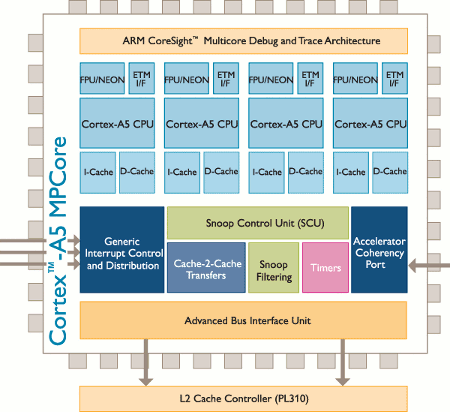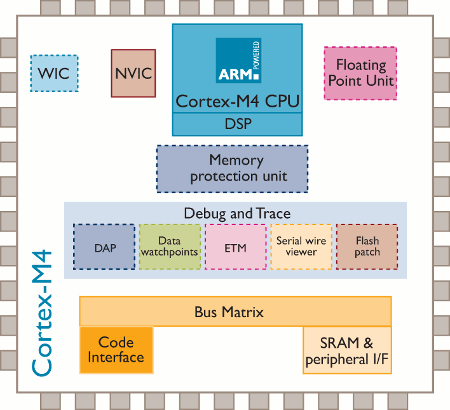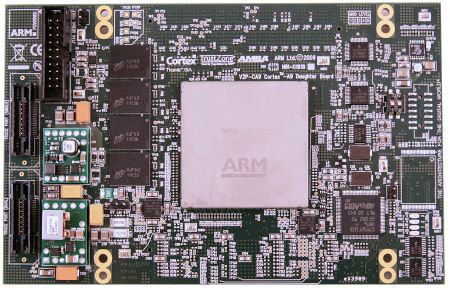SoC teams Cortex-A5 app processor with Cortex-M4 MCU
Oct 25, 2011 — by Eric Brown — from the LinuxDevices Archive — 54 viewsFreescale Semiconductor announced a system on chip (SoC) platform, combining a Linux-ready ARM Cortex-A5 application processor with a Cortex-M4 microcontroller intended to run a real-time operating system (RTOS). The company's unnamed “asymmetrical-multiprocessing-architecture” SoC features a wide range of peripherals, and is designed to enable simultaneous real-time control and graphics-rich application processing, primarily in industrial applications.
At this week's ARM TechCon conference in Santa Clara, Calif., Freescale announced plans to feature ARM's Cortex-A5 processor in tandem with ARM's Cortex-M4 microcontroller (MCU). The A5 supports high-end operating systems such as Linux, while the real-time focused M4 does not run high-end OSes. (See farther below for more background on the Cortex-A5 and -M4.)

Architecture for upcoming Freescale combination SoC
Source: EETimes
Freescale's unnamed product features an "asymmetrical-multiprocessing-architecture," as well as an inter-process communication (IPC) application programming interface (API) to bridge the two environments. With the IPC API, developers can create differentiated applications with the upcoming SoC "without worrying about how the high-level OS (like Linux) and RTOS (such as MQX) communicate with each other," says the company.
Freescale plans to introduce a software development platform for the SoC later this year, and the silicon is scheduled for sampling in the first quarter of 2012. The combo SoC will support multiple operating systems, and will ship with reference designs for industrial applications, says Freescale.
The SoC will feature support for programmable timers, on-chip memory, flexible memory interfaces, and security features, says the company. Peripherals are said to include high-speed communication interfaces, analog-to-digital converters, and digital-to-analog converters.
The combo SoC is primarily aimed at industrial applications such as factory automation, as well as medical devices and appliances, says Freescale. A derivative SoC family designed for the automotive infotainment market will be announced in the second quarter of 2012, says the company.
The focus on the initial SoC is said to be on devices that require a GUI front end for sophisticated human-machine interfaces (HMIs), but also need to perform deterministic, real-time operations controlled by an RTOS. The SoC avoids the expense and complexity of integrating an applications processor with a real-time controller, and offers a faster interconnect between the two, claims the company.
Cortex-A5 background
ARM announced its Cortex-A5 design in Oct. 2009, but the A5 has been something of a forgotten processor. The attention has been on the Cortex-A9 processor, which is defining a new range of Android smartphones and tablets, as well as the upcoming, powerhouse Cortex-A15.

Cortex-A5 block diagram
Last week, ARM announced the Cortex-A7, which can be considered the big brother to the Cortex-A5. Both processors are Cortex-A8-, -A9, and -A15 compatible and use the ARMv7 architecture. Whereas the Cortex-A7 is said to be the heir to the Cortex-A8, the Cortex-A5 is instead intended to replace ARM9 and ARM11 processors, largely in more industrial and embedded applications.
In ARM's 2009 announcement, the 40nm-fabricated Cortex-A5 was touted as being "the smallest, lowest power ARM multicore processor capable of delivering the Internet to the widest possible range of devices." Target devices were said to include ultra low cost handsets, feature phones, and smart mobile devices, as well as pervasive embedded, consumer, and industrial devices.
The A5 appears to lack the superscalar technology of the A8 and A9 models, which allows those processors to provide instruction-level parallelism for greater performance. Like the A9 and ARM11, however, the A5 supports ARM's MPCore interconnect technology, enabling multicore designs up to four cores. (Freescale's mystery SoC is referred to as a dual-core model, but this may refer to the combination of the A5 and M4 cores, rather than dual A5 cores.)
Comparing uni-processor versions, the Cortex-A5 was touted as delivering better performance than the ARM1176JZ-S within the raw power and silicon area footprint of the ARM926EJ-S. The Cortex-A5 also supplies "nearly twice the power-efficiency" of the earlier cores, says ARM. The company adds that performance is "further enhanced" in the multicore versions of the Cortex-A5.
The Cortex-A5 processor also integrates Cortex technologies like ARM's TrustZone security technology, and the Neon multimedia processing engine.
Two versions of the design are offered: a TSMC 40LP version that can be clocked to between 530MHz and 700MHz and offers 13 DMIPS/mW power efficiency, and a TSMC 40G model that can be clocked to 1GHz and offers more than 20 DMIPS/mW efficiency, according to Freescale.
Operating system support for the Cortex-A5 is said to include Android, Adobe Flash, Linux, Microsoft Windows CE/Mobile, Symbian, and Ubuntu Linux. The platform also supports JavaFX and Java Platform Standard Edition (Java SE), says ARM.
So far there have been few announcements of Cortex-A5 processors. One exception is the upcoming "location-aware" SoC that was announced by CSR plc in January. The navigation SoC will include Cortex-A5 or Cortex-A9 cores, according to the company, which is known for its SiRF line of GPS and communications chipsets.
Cortex-M4 background
Freescale offers the industry's broadest portfolio of multiprocessors based on the ARM Cortex-M4 MCU core, claims the company. This is said to include its Kinetis MCU line, which is now in production.

Cortex-M4 block diagram
Designed to run RTOSes, the M4 is said to offer 32-bit processing, DSP extensions, a floating point unit, and 1.25 DMIPS/MHz performance. The processor runs Thumb and Thumb-2 instructions, and offers an optional eight-region MPU (memory processor unit) with sub regions and background region, says Freescale.
Freescale's mystery SoC is not the first to combine the Cortex-M4 with higher end Cortex designs intended for application processing. In February, Texas Instruments announced the OMAP5430 and OMAP5432, which combine dual 2GHz Cortex-A15 cores with dual Cortex-M4 cores. The M4s provide real-time processing, and help "improve low-level control and responsiveness of mobile devices," TI said at the time. TI's OMAP processors are expected to sample this fall.
The combination of disparate architectures within a single SoC appears to be a growing trend. Last week, in announcing the Cortex-A7, ARM also said it was working on a "big.Little" SoC design that combines the Cortex-A7 with the Cortex-A15 processor. The design features a 20-microsecond interconnect between the two, says ARM.
ARM's CoreTile Express for Cortex-A5
In August, ARM released a development board for prototyping Cortex-A5 processor-based SoC designs.The CoreTile Express for Cortex-A5 (pictured below) is a daughterboard that plugs into the Motherboard Express micro-ATX platform. Custom peripheral logic can be validated in an adjacent FPGA (field programmable gate array) by linking the CoreTile Express to an optional LogicTile Express board, says ARM.

ARM CoreTile Express for Cortex-A5
The board ships with dual Cortex-A5 cores, each clocked at just 100MHz, and each with 32KB/32KB of L1 cache and 256KB of L2 cache. There's also 1GB of DDR2 SDRAM, as well as JTAG and trace functionality, says ARM.
Stated Tony Massimini, chief of technology for Semico Research, "Freescale is taking a unique approach with a new product platform that merges an apps processor and real-time controller into one device to reduce complexity and cost, combined with a 'software before silicon' strategy for earlier software development."
Stated Reza Kazerounian, senior vice president and general manager of Freescale's Microcontroller Solutions Group, "We're the first to provide extensive MCU and apps processing capabilities in an integrated hardware-software based solution, setting a new standard for the design of systems that need rich apps in real time."
Availability
Freescale plans to offer the initial software development platform for its new product platform later this quarter and intends to announce the first industrial-focused eMPU product families based on the new architecture in Q1 2012, says the company. Automotive device details will be announced in Q2 2012.
More information should eventually appear at Freescale's website. More on the Cortex-A5 may be found at ARM's Cortex-A5 page.
This article was originally published on LinuxDevices.com and has been donated to the open source community by QuinStreet Inc. Please visit LinuxToday.com for up-to-date news and articles about Linux and open source.